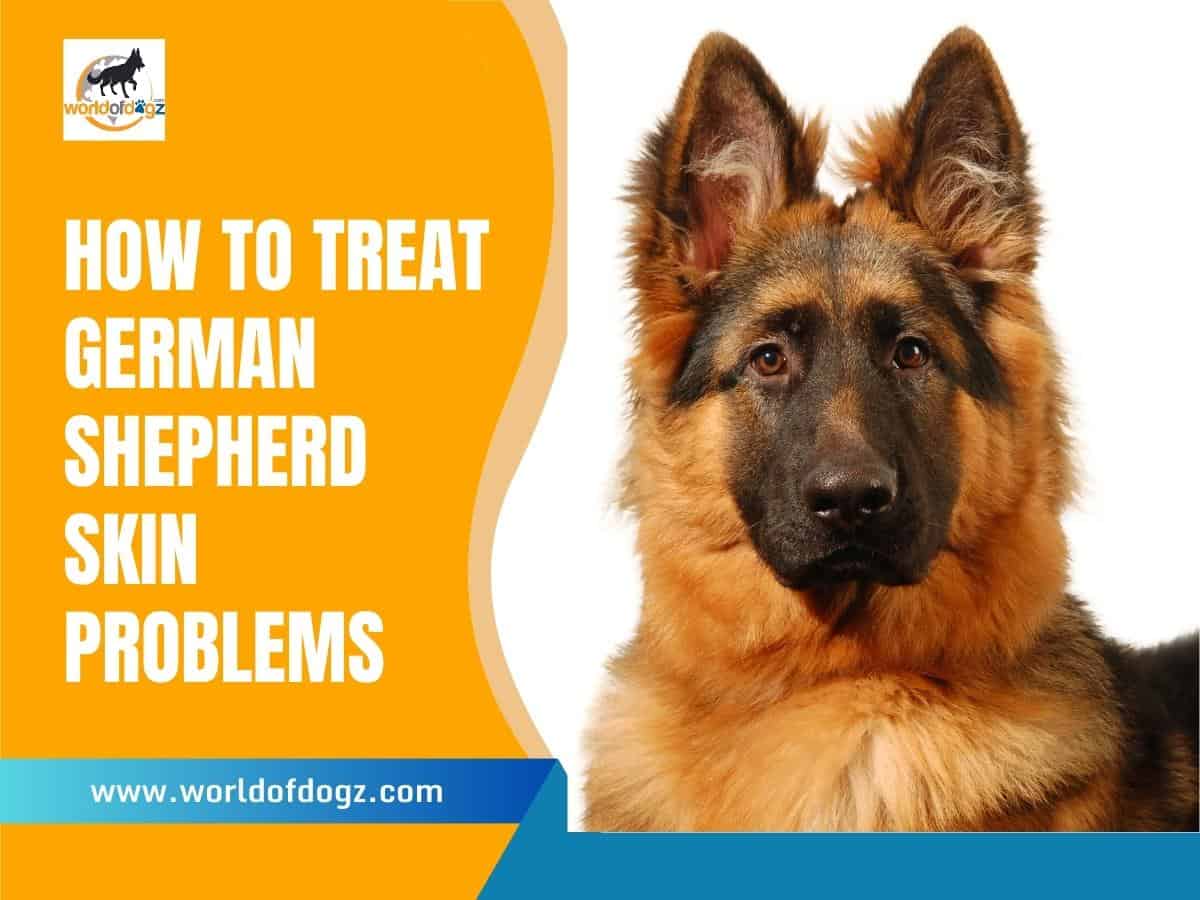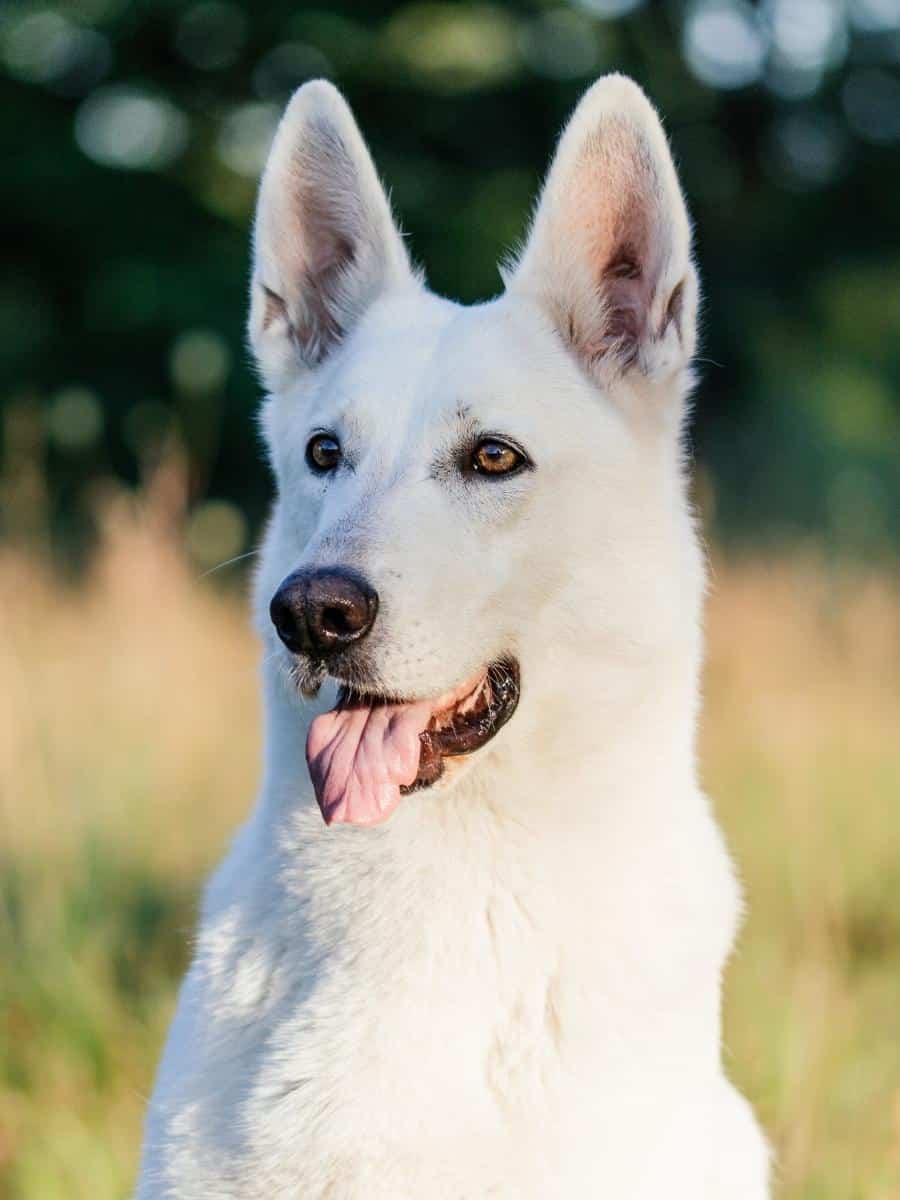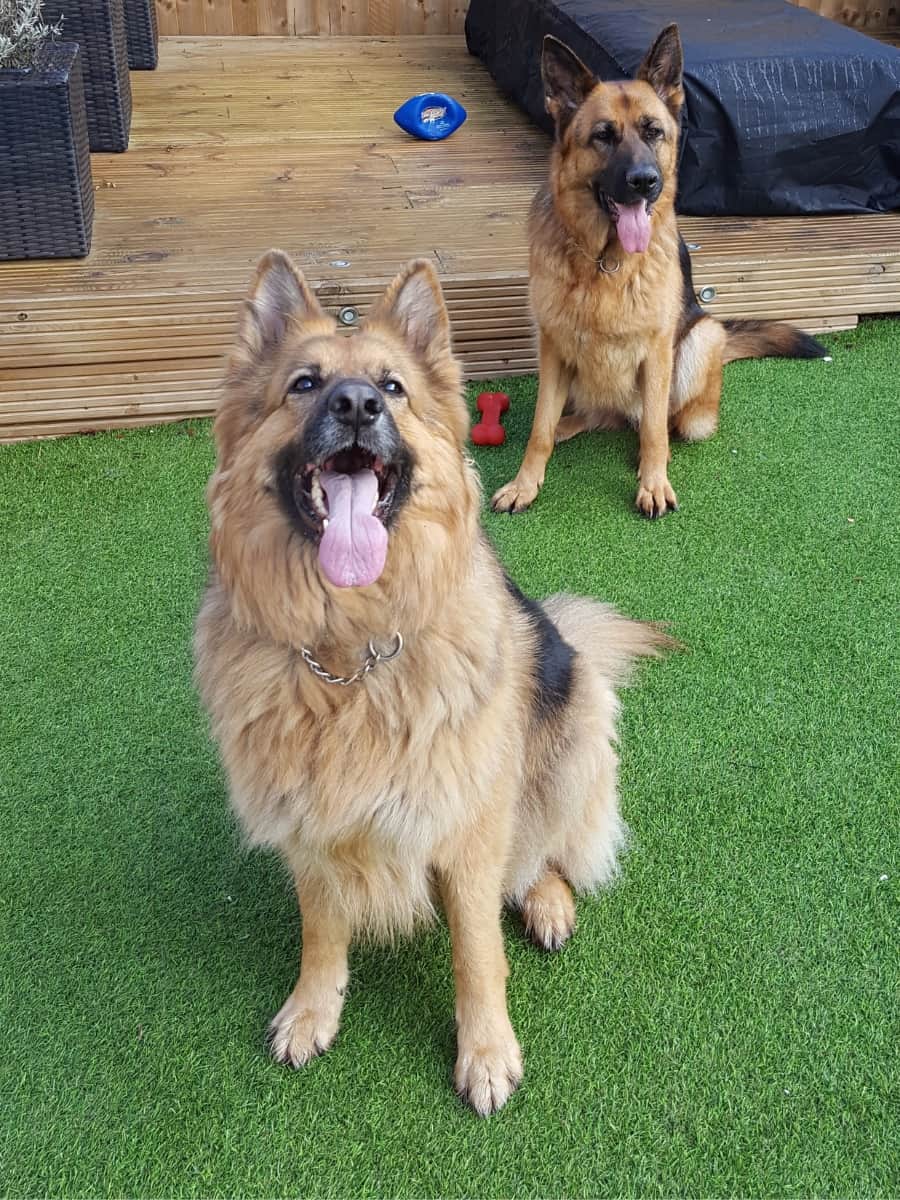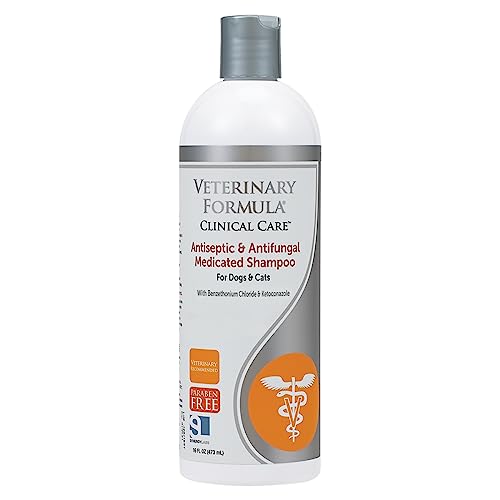Have you lately noticed that your German Shepherd has an unpleasant odor, red and flaked skin, rashes, lesions, hair loss, or a tendency to scratch due to itching? If so, your dog is likely suffering from a skin problem. If that’s the case, you’ve probably wondered how to treat German Shepherd skin problems.
To treat German Shepherd skin problems, use safe dog shampoos for mild skin problems. Severe skin problems like dermatitis and allergy skin issues require a vet prescription for topical and oral antifungal or antihistamine drugs. Treatment depends on the cause and symptoms of the condition.
In this blog post, we’ll look at the conditions possibly causing your dog’s discomfort and go over some tips and tricks on how to treat your German Shepherd’s skin problem and keep your pup happy and healthy.

How To Treat German Shepherd Skin Problems
Because treatment is specific to German Shepherd skin problems, we will discuss some of the most common skin problems affecting GSDs and how each is treated at home or by the veterinarian.
Let’s start with a skin problem that German Shepherds are highly prone to.
Canine Atopic Dermatitis
Canine Atopic Dermatitis (CAD) is an inflammatory and pruritic allergic skin disease with genetic and environmental predisposing factors. This risk factor explains its other name, Environmental Allergy.
Dogs most prone to CAD have atopy, a genetic predisposition to produce an abnormal Immunoglobulin E immune response. This happens even when they come into contact with materials in the environment that would otherwise be harmless.
Dogs with CAD will present the typical symptoms of the condition, including:
- Extreme itching or pruritis, especially on the elbows, feet, anal area, and the face.
- Skin redness.
- Hair loss from scratching and itching.
- Dark and thickened skin spots.
- Secondary infection on the belly, legs, and tail, especially in progressed cases.
Unfortunately, German Shepherd report a genetic predisposition to atopy in research studies. That means you might need to treat your GSD for canine atopic dermatitis at some point in his life.

How to Treat Canine Atopic Dermatitis in German Shepherds
Vet experts have not found a conclusive diagnostic test for CAD. As such, CAD diagnosis relies on the signs and symptoms.
At home, you can provide relief for your GSD suffering from canine atopic dermatitis with home remedies such as aloe vera, oatmeal, chamomile, apple cider vinegar, Epsom salt baths, or a coconut oil topical application.
My favorite soothing option is Vet’s Best Hot Spot Itch Relief Spray. Veterinarians also recommend it, and it helps to soothe hot spots and skin irritation immediately. It includes natural key ingredients, including aloe vera, tea tree oil, and chamomile.
- IMMEDIATE RELIEF - Vet’s Best Hot Spot Spray for Dogs provides immediate relief for itchy, dry, and irritated dog skin on contact, helping to soothe hot spots and seasonal skin irritation.
- PLANT-BASED INGREDIENTS - A unique blend of natural key ingredients, including tea tree oil, aloe vera, and chamomile, provides fast and effective relief.
- NO-STING FORMULA - Our alcohol-free, no-sting formula provides soothing relief for red, raw, or inflamed skin. Does not contain steroids such as hydrocortisone.
- IT WORKS - Guaranteed effective and will not affect topical flea and tick control products.
- VET’S FORMULA - Veterinarian formulated and recommended, and made in the USA with quality US and imported ingredien
Prices pulled from the Amazon Product Advertising API on:
Product prices and availability are accurate as of the date/time indicated and are subject to change. Any price and availability information displayed on [relevant Amazon Site(s), as applicable] at the time of purchase will apply to the purchase of this product.
Itch relief shampoos will also help with symptoms such as Vets’ Best Allergy Itch Relief Shampoo.
At the vet, your dog’s doctor will give short-term anti-itch and anti-inflammatory corticosteroid drugs to manage the condition, such as prednisolone. Alternatively, the vet may propose systemic therapies with antihistamines, glucocorticoids like dexamethasone, or anti-allergy vaccines.
Pyotraumatic Dermatitis (Hot Spots)
Pyotraumatic Dermatitis, also known as hot spots or acute moist dermatitis, is a self-inflicted skin disorder in dogs.
The skin issue arises following itching and continuous biting or scratching due to other skin problems like fleas and ticks. Skin inflammations, discomfort from muscle and joint diseases, anal gland inflammation, or skin allergies are also possible root causes for scratching and biting.
Pyotraumatic dermatitis can affect dogs of any breed, especially those with long or thick coats, like German Shepherds.
Signs of acute moist dermatitis include:
- Continuous scratching, licking, or chewing due to a persistent itch
- Hair loss from consistent scratching or biting.
- Redness on the hot spot.
- Moist and oozing skin lesions.
- Bad odor.
How to Treat Pyotraumatic Dermatitis in German Shepherds
The best way to treat your German Shepherd for Pyotraumatic Dermatitis is to prevent the occurrence of inflicted skin trauma in the first place. If the dermatitis has already happened, you must take curative measures.
Here are the 3 steps to treating Pyotraumatic dermatitis both at home and at the vet’s:
- Use an E-collar (Elizabethan collar) to deter your dog from scratching or biting the hot spot.
- Use a barrier on the hotspot, such as a bandage or sock.
- Visit a vet for treatment. The dog doctor will remove the hair on the location, disinfect the hot spot, and apply a topical anti-inflammatory medication.
Depending on the extent of the case, your GSD may also get oral drugs and a topical treatment to bring home.
As an additional precaution, eliminate the triggering cause. This could mean administering antihistamines for allergic reactions, flea and tick medication, and anti-inflammatory drugs for musculoskeletal issues like arthritis.
Yeast Dermatitis
Yeast Dermatitis, also called fungal dermatitis or scientifically Malessezia Dermatitis, is a skin problem in dogs caused by the Malessezia Pachydrmatis fungus.
While German Shepherds are not listed among dog breeds most prone to yeast dermatitis, your dog can still from suffer the condition. What’s more, the fungus is considered a common cause of skin issues in dogs.
Yeast dermatitis presents in skin inflammation and is an indication the yeast on the skin is growing abnormally or rapidly.
Often, yeast dermatitis is a secondary condition resulting from other skin issues like the canine atopic dermatitis discussed earlier or flea bite allergy.
Humidity, altered skin pH, skin folds, prolonged use of antibiotics, or corticosteroid treatments can all facilitate the growth of fungal dermatitis in your dog.
If your German Shepherd has yeast dermatitis, you will notice these signs and symptoms:
- Scratching from extreme pruritis.
- Redness of skin.
- A musty odor.
- Elephant or thickened, crusty skin with a scale-like appearance.
- Skin hyperpigmentation with a dark tone.
- Recurrent ear infections.
How to Treat Yeast Dermatitis in German Shepherds
At home, you can use an antifungal shampoo to manage yeast dermatitis symptoms or as a preventative option.
Consider a vet formula such as the Veterinary Formula Antifungal Medicated Shampoo. The shampoo is soap and paraben-free and will not cause your German Shepherd skin irritation.
- HELPS SUPPORT HEALTHY SKIN - With a wash and soaking of the coat for 5-10 minutes, our powerful ingredients work to help soothe red, scaly, greasy, or smelly skin that may cause your pet discomfort.
- FAST ACTING – Works fast to soothe your pets sensitive skin that may be affected by environmental stressors.
- VET-RECOMMENDED – This pet shampoo is pH balanced for your pets skin and is paraben and soap-free to promote overall skin and coat health without damaging detergents.
- FOR DOGS AND CATS – Our cat and dog shampoo is intended for pets over 12 weeks of age. Use twice weekly until skin clears up, then once a week to help maintain skin health.
- APPLICATION: This product is intended for topical use only. Read directions carefully before applying to your pets coat. Test on a small area to avoid further sensitivity before usi
Prices pulled from the Amazon Product Advertising API on:
Product prices and availability are accurate as of the date/time indicated and are subject to change. Any price and availability information displayed on [relevant Amazon Site(s), as applicable] at the time of purchase will apply to the purchase of this product.
For best results, use the shampoo at least twice weekly until the symptoms are under control. You can then use it once weekly to keep the yeast in check.
Because yeast can be hard to control, I recommend visiting the vet. Your dog’s vet will likely perform a cotton swab, skin scraping, or skin biopsy to confirm the diagnosis.
Once confirmed, the vet will put your German Shepherd on a topical antifungal cream, usually applied daily for 2-12 weeks. If your dog’s case is severe, the vet will also give oral antifungal drugs like fluconazole or ketoconazole. These are typically administered for 4-12 weeks.
It’s important to remember that home treatments, even with a shampoo formula, should always get a tick from the vet first.
Food Allergies and Intolerances
Food allergy is a common incidence in dogs. It occurs when your dog’s immune system is alarmed and responds by producing antibodies due to generally safe food.
Food intolerance is also called food sensitivity. It happens when your dog’s stomach is overly sensitive to compounds in food and cannot digest them.
Dogs usually manifest food allergy and intolerance towards dairy products, meats like beef and chicken, eggs, fish, rice, corn, canned food, and foods with artificial additives, among others.
Studies have found that German Shepherds are among the dog breeds most prone to food allergies and intolerances.
If your GSD has food allergy or intolerance, he will show signs similar to many pruritic skin problems, alongside stomach problems. These signs and symptoms include:
- Pruritis or itchy skin, ears, and paws.
- Hives or a red skin rash.
- Licking or biting on itchy spots
- Itchy and runny eyes.
- Digestion issues.
- Vomiting and diarrhea.
Food allergy skin issues can lead to some of the other German Shepherd skin problems discussed above, including canine atopic dermatitis and hot spots.

How to Treat Food Allergy and Intolerance in German Shepherds
German Shepherd owners can test if their dog has a food allergy at home using food elimination trials.
This method entails feeding your dog with a diet that does not include any of the ingredients in his usual food. The goal is to notice if the skin and other allergic reactions disappear after a week or so.
Once confirmed, you should eliminate the ingredients in your dog’s usual food one by one. By the end of the trial, you will know what food or ingredient you should not feed your German Shepherd.
Food elimination trials can be tedious for you and straining for your GSD. Nonetheless, experts consider it a more effective method for diagnosing food allergy in dogs than the serum Immunoglobulin E tests that veterinarians perform.
At the vet, your dog’s doctor may give an antihistamine to control the food allergy and intolerance symptoms. For a more long-term solution, the vet will recommend a hypoallergenic diet for your German Shepherd dog.
Other Skin Problems in German Shepherds
Other less severe and uncommon skin problems can affect your German Shepherd. For the majority of these skin problems, treatment stays in management baths with anti-allergic, anti-itch, or antifungal shampoos, depending on each case.
In addition, eliminating the root cause of the skin condition is a necessary preventative measure.
Below is a non-exhaustive list of other skin problems that may affect your German Shepherd:
- Flea allergy dermatitis.
- Ringworms.
- Mange.
- Seborrhea.
- Canine acne.
- Folliculitis
Remember that the symptoms and signs of these skin problems in German Shepherds can be similar. So, the best way to know which skin issue affects your dog is to always work with your dog’s vet.
Final Thoughts
Any owner who has had to ask how to treat German Shepherd skin problems will be relieved to know that they can easily manage the signs and symptoms of most dog skin problems at home with safe dog shampoos. However, it is also crucial to note that the safest option for your dog is to always seek the counsel of a vet.
Skin problems can be extremely uncomfortable for your German Shepherd and provoke emotional stress and anxiety if left unattended.
As such, you should take any skin problem in your GSD as an emergency medical issue. Do this as soon as you notice it, way before the symptoms escalate.
Related Posts You May Like:







